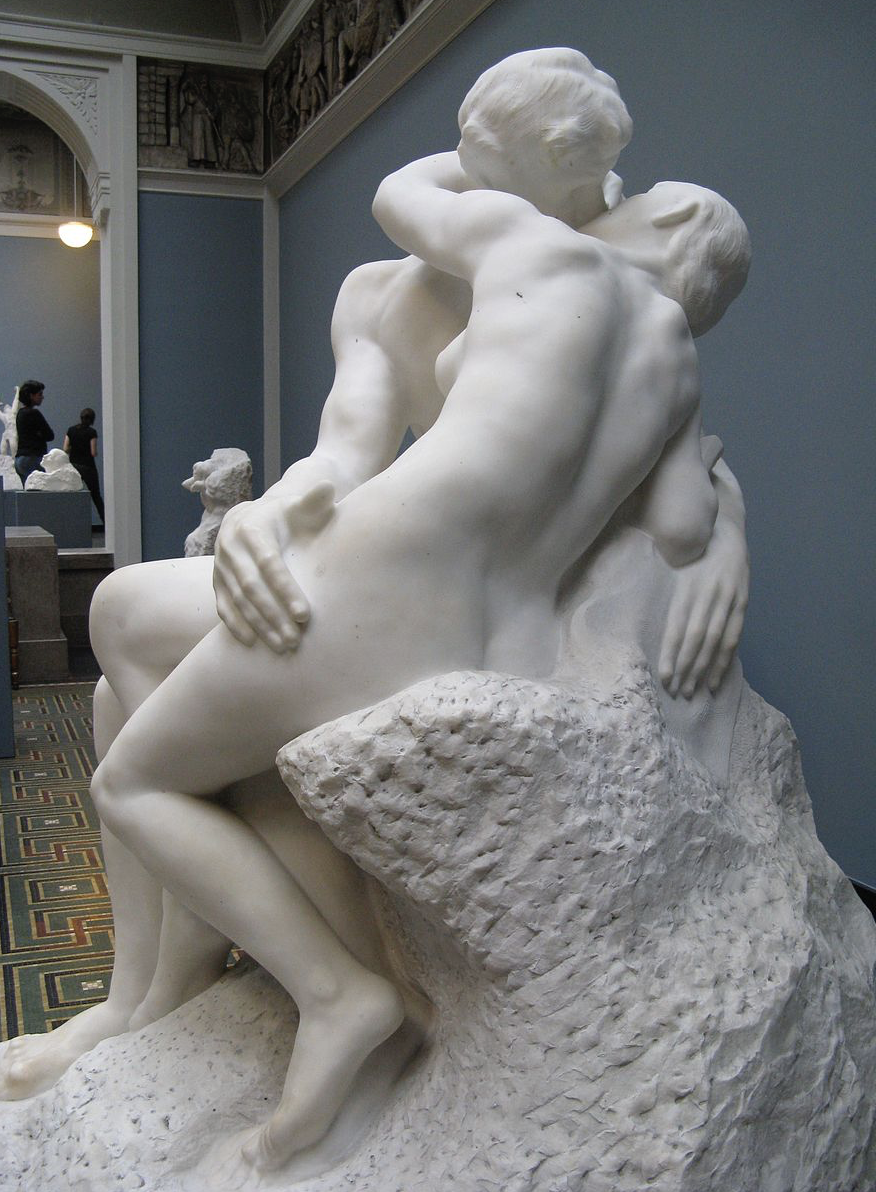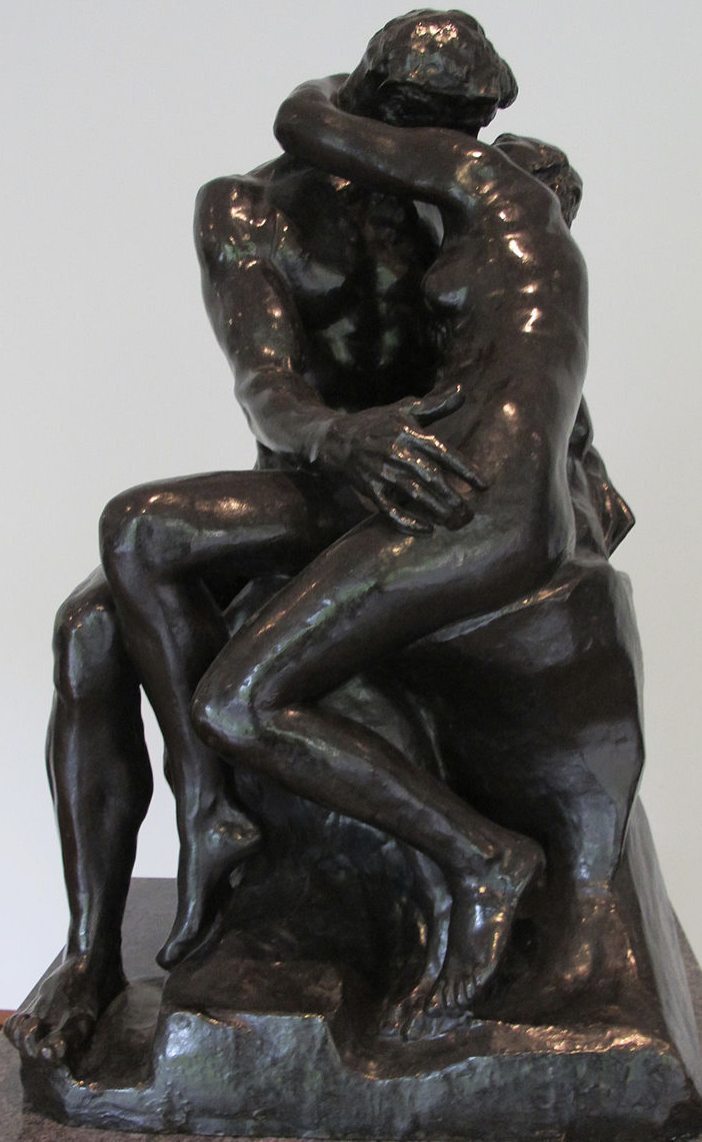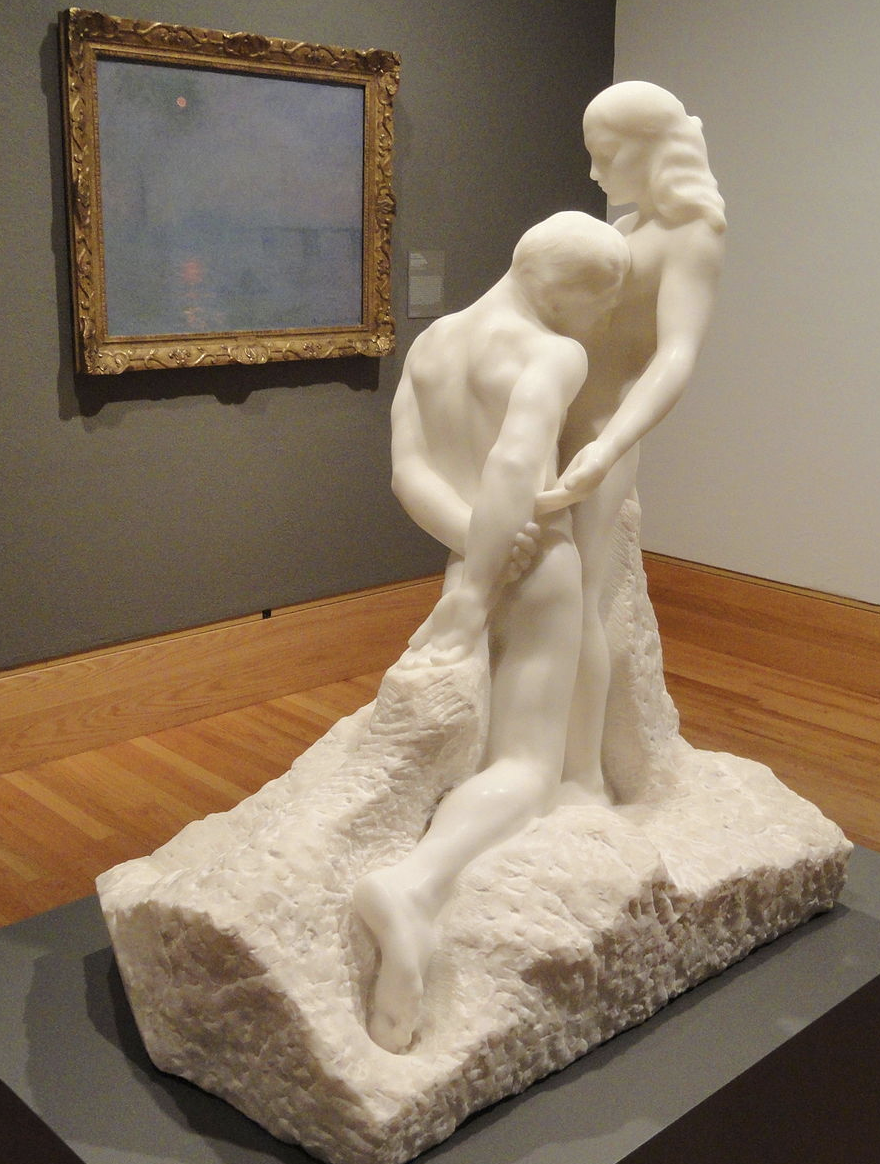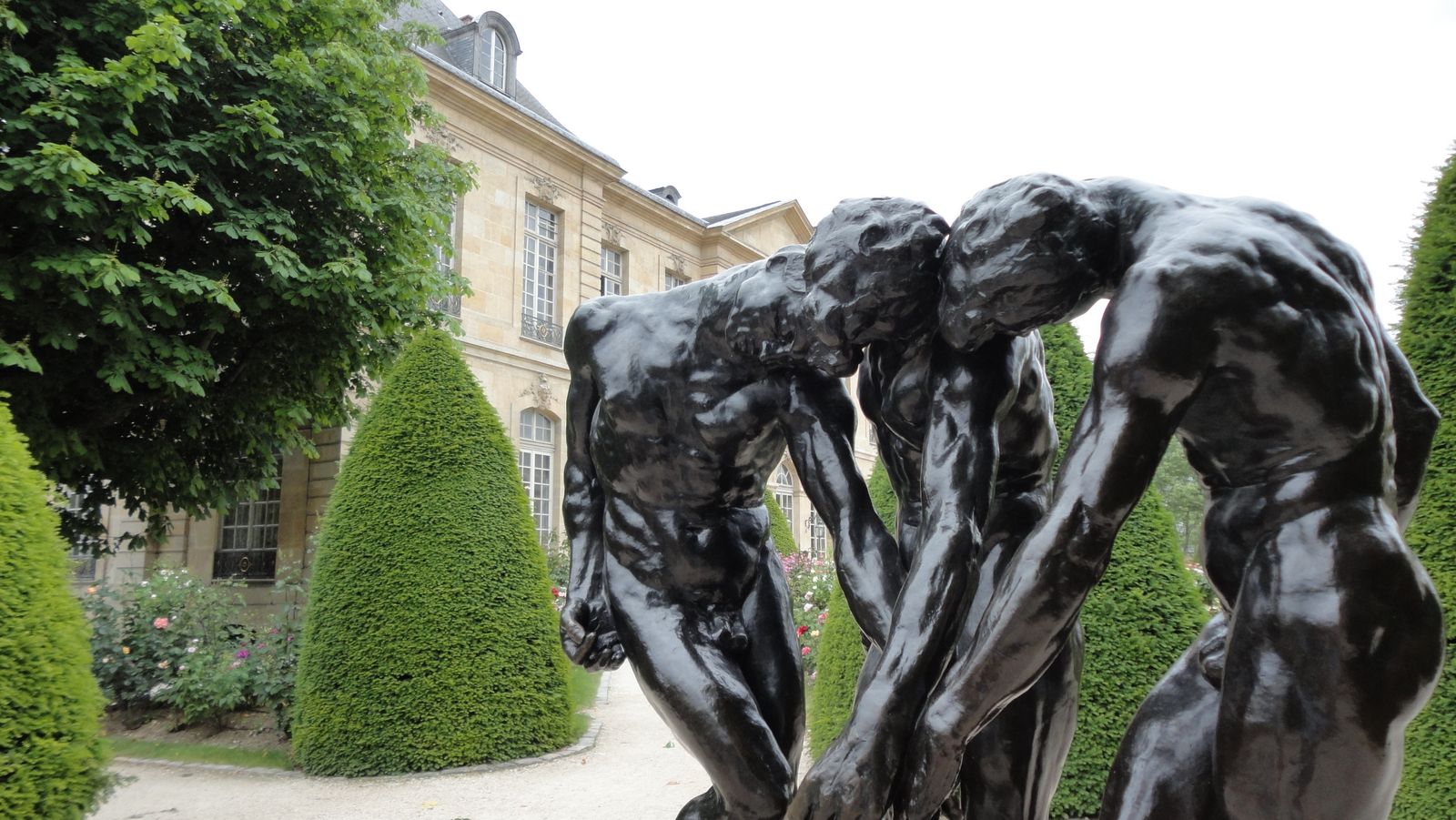by Amineddoleh & Associates LLC | Feb 14, 2023 |

Auguste Rodin, The Kiss, Ny Carlsberg Glyptotek in Copenhagen. Image courtesy of Yair Haklai via Wikimedia Commons
It’s Valentine’s Day, and there is no better way to celebrate the holiday of romance than to highlight a famous sculpture depicting an illicit affair.
The work at the heart of today’s post is Rodin’s The Kiss. This sculpture, created with Rodin’s trademark precision and expressiveness, was inspired by Dante’s Inferno. It portrays two tragic lovers, Paolo and Francesca, locked in a passionate embrace. What makes their love so tragic is that it was doomed from the start: Paolo was Francesca’s academic tutor, and Francesca was engaged to Paolo’s brother. According to Dante’s epic, the pair’s tutoring session began routinely, but went a bit off book after Paolo began to read an Arthurian legend to Francesca. The conquests of King Arthur’s Court did it for the duo, and the physical reaction portrayed by Rodin’s statue was the saucy result.
This was a win for love, but a loss for morality. As a result, Paolo and Francesca were both damned to Hell, where the two suffered for their sins, but remained together even after death.
The Kiss is one of Rodin’s most beloved works, and it caused a stir following its production. This is likely because in 1881, the time of casting, The Real Housewives franchise was not on TV in France. Patrons looked to art for their fix of dramatic scandal and found it in The Kiss.

Auguste Rodin (French, 1840-1917): The Kiss, bronze, National Museum of Western Art, Tokyo, Japan, image courtesy of Sailko via Wikimedia Commons
The original sculpture of The Kiss, done in bronze, was created by Rodin as part of a commission by The Decorative Arts Museum in Paris. This museum was never established, but the commission itself ended up producing a fantastic group work by Rodin, including The Kiss. The group work, entitled The Gates of Hell, is a monumental sculpture of Rodin pieces. The Kiss was created as part of this work. However, it was later removed from the larger group and took on a life as a stand-alone piece.
Continuing to set the bar for “relationship goals,” Rodin outdid himself on another set of sculptural figures originating from The Gates of Hell. This next duo is entitled The Eternal Idol. The work shows a woman gazing down upon a man who kneels at her feet in devotion. The lovers made an impression on viewers at the time of creation. Famed poet and author Rainer Maria Rilke, who took cues from Rodin’s creative process in his own work, said of the piece that the work “[a]lways [has] the same enchanting strength. You dare not design a single meaning to it.”

Eternal Idol, executed by Jean Escoula. Exhibit in the Fogg Art Museum, Harvard University, Cambridge, Massachusetts. Image courtesy of Daderot via Wikimedia Commons
While the meaning of the work remains mysterious, art historians have a few good guesses as to who in Rodin’s life inspired the passion portrayed in this work. It is no secret that Rodin often relied on his famous sculptor and colleague Camille as inspiration, model, and muse. The best evidence of the romantic entanglement between the two comes from Rodin’s surviving letters to Camille Claudel. Rodin puts Hallmark to shame in his elaborate prose, writing in 1844 to his muse:
“My very dearest down on both knees before your beautiful body which I embrace.”
Fans of Rodin may have seen a version of The Eternal Idol and The Kiss in real life. In fact, of The Kiss, four large marble versions are known to exist – the three largest being in the Tate Modern in London, The Ny Carlsberg Glyptotek in Copenhagen, and (of course) The Musèe Rodin in Paris. Smaller versions, most commonly cast in bronze, can be found across the globe, including a wonderful bronze casting of The Kiss in the Rodin Court at the North Carolina Museum of Art in Raleigh, NC.
Just how many casts of The Kiss are known to exist? The Barbedienne Foundry alone has produced 319 authentic versions. Of these, only the first twelve are permitted to be called “original editions” under the French law which permits the reproductions. The law in question is the product of a unique aspect of Rodin’s artistic legacy. In his will, Rodin gave French museums permission to cast reproductions of his works after his death. The casts were to be made using either Rodin’s original molds or new molds that were made from his originals.
On the one hand, this means that Rodin’s works are able to be enjoyed and experienced on a broader global scale. On the other hand, this legal twist that permits certain kinds of reproductions – at the exclusion of others – plus Rodin’s worldwide popularity, make Rodin’s sculptures rife for forgery.

Musée Rodin, Paris. Image courtesy of Michael Scaduto via Wikimedia Commons
A famous example of Rodin copies coming under fire occurred in 2019, at the conclusion of a nearly two-decade legal controversy involving two art dealers, American Gary Snell and Frenchman Robert Crouzet. According to the court documents, Snell had cast upwards of 1,700 Rodin sculptures – a remarkable amount for one dealer. To make each sculpture, Snell used one of the sixteen molds illegally passed along to him by Crouzet. The alleged total sale price of the sculptures the pair sold amounted to over $72 million.
Snell and Crouzet might have been able to avoid prosecution for their reproductions, had they complied with the French law. For example, if Snell had made it clear to buyers that the reproductions were – in fact – reproductions, and not authentic Rodins, both Snell and Crouzet may have avoided liability. But because Snell failed to make it clear to buyers that they were buying reproductions, and not official copies, he and Crouzet both faced sentencing by the French State.
Several factors exacerbated the duo’s complicity, including the fact that some works included a forged Rodin signature. Many copies also included forged authentication documents from the official French foundry, the Founderie Rudier. Moreover, several of Snell’s copies departed from Rodin’s exact molds, creating sculptures that were slightly distorted. Snell was not a sympathetic plaintiff. He complained that if he had made it clear to buyers that he was selling unofficial reproductions, he likely would not have been able to charge as much per statue. Not to be outdone, his lawyer blurted out to the court that this lawsuit had “totally ruined” his client’s livelihood as an art dealer.

Rodin Museum, Paris
Copyright: Leila A. Amineddoleh
Such protestations did not result in a lot of love for Snell, Crouzet, or their attorneys. What is there to be said? The French State loves Rodin and will stop at nothing to protect and ensure the authenticity of the artist’s rich legacy. This level of devotion deserves a French kiss. However, in order to avoid a repeat of Dante’s ill-fated lovers, aim to make it Hershey’s.
by Amineddoleh & Associates LLC | Jan 26, 2023 |
Our founder, Leila A. Amineddoleh, was featured in the Washington Post last week. She discussed challenges facing claimants following a complaint made against the Guggenheim Museum for retaining a Picasso that was allegedly sold under Nazi duress. Read more here. Leila was also quoted this week in an article for ABC News discussing the ethical implications of resolving cultural antiquities ownership disputes. Read her take here.
Additionally, Maria T. Cannon contributed an opinion to the Wall Street Journal last week. She commented on the ethical implications of attorneys who may be tempted to use ChatGPT while representing clients. Find the article here.
by Amineddoleh & Associates LLC | Jan 26, 2023 |

Madonna in concert in 2005. Credit: David Cushing, https://www.flickr.com/
Madonna, singer of “Vogue” fame, has been asked to negotiate a loan of an 1822 Jerome-Martin Langlois painting from her personal art collection. The mayor of Amiens requested that the singer loan the work to the Musée de Picardie in the French city. The painting was purchased by Madonna in 1989 at auction, around the time that the singer’s fourth studio album was released. Decades later, in 2015, a museum curator recognized the painting after Madonna was featured in an issue of the weekly publication Paris Match Magazine. The article included a photograph of the “Material Girl” in her home, with the painting visible in the background.
When the curator examined the subject matter of the painting in the photo – a small Cupid in flight dashing between Roman mythological figures Diana and Endymion – a match was made. The painting looked remarkably similar to a work once owned by the Musée de Picardie and thought to have been destroyed by World War I bombings. Further inquiry revealed that the painting once thought lost is very likely the work hanging in Madonna’s home.
Notably, the city of Amiens has not accused Madonna of any wrongdoing, and it is not demanding the restitution of the work. Rather, the city has requested a loan. Such a deal could be fortuitous for both Madonna and the city of Amiens. Madonna would keep the painting in her private collection following the loan, and Amiens could display the painting in its original glory. Moreover, Amiens would no doubt benefit from the added publicity of a loan from such an A-list celebrity. This would be particularly timely for the city, coincidentally gunning to be named the Cultural Capital of Europe in 2028. (Amiens, among other cities such as Brovmov in the Czech Republic and Skopje in North Macedonia, are on the most recent short list for the recognition).

Diana and Endymion, Jérôme-Martin Langlois, 1822, Credit: Public Domain
Madonna has yet to respond to the loan request. Her decision whether to accept or reject the offer to negotiate might be influenced (hopefully, positively) by certain outcomes of other high-profile celebrities who have faced ownership claims against artwork held in their personal collections.
Other Celebrities With Problematic Art
One path for some has been to return the work outright. As we discussed previously, Nicolas Cage returned a dinosaur skull he bought at auction once it was established that it had been illegally excavated. Another 80s icon, Boy George, was keen to return a contested piece to its claimant owner. In 2011, the stylish singer returned an icon to Cyprus, to later be reinstalled in the Church of St. Charalambos. The church’s bishop saw the icon in the background of a video interview filmed in Boy George’s home. He recognized the piece as one stolen from the church following Turkish invasion in 1974. Boy George’s graciousness in returning the piece is heartening (he went on record as “happy [to see] the icon going back to its original home.”
Another path forward for celebrities with problematic artwork is to negotiate in good faith with the claimants, in lieu of lengthy and costly litigation. Take, for example, a piece put up for auction by the stewards of the late Gianni Versace’s private art collection. In 2010, a painting that once hung in Versace’s Lake Como villa was consigned for auction at Sotheby’s in London. The listing, a portrait by Johann Zoffany entitled Portrait of Major George Maule caught the eyes of the direct descendants of the painting’s owner. The descendants contacted the Art Loss Register, who negotiated with Sotheby’s. After what was reported as an amicable mediation, the piece was pulled from auction. The work was returned to its original owners, who were “overjoyed” to be able to hang the painting from their own walls.

Van Gogh’s Vue de l’Asile et de la Chapelle de Saint-Remy, gracing the catalog cover for the sale of Elizabeth Taylor’s collection (Credit: Christie’s LLC)
Negotiating has also proven to be a feasible and mutually beneficial option for the Andrew Llyod Webber Art Foundation. After the Foundation put up a Picasso for auction at Sotheby’s in London, heirs of a Jewish family claimed that the work was sold under duress to the Nazi Party by their ancestor. In 2010, the parties reached an agreement of undisclosed terms (and, as the painting is valued at over $60 million, a substantial award was likely given to the family). Following the negotiations, the family willingly relinquished all ownership claims of the work, and seemingly walked away content with their end of the bargain.
However, some celebrities – either with the budget for litigation or incredibly personal ties to the contested work at issue (or both) – are willing to fight in court. Elizabeth Taylor is one example. She defended herself in litigation after she was contacted about a piece in her personal art collection in 2004. The 1889 work, a Van Gogh painting entitled View of the Asylum and Chapel at Saint Remy, was sold at auction to the actress at Sotheby’s in London in 1963. Decades later, descendants of a Jewish woman named Margarete Mauthner claimed that the painting was rightfully theirs. They asserted that it had been sold by their ancestor under duress by Nazis. The Orkin family sought redress under the 1998 U.S. Holocaust Victims Act, but was barred from recovery due to the statute of limitations. The 9th Circuit upheld the lower court ruling that the Orkin family had missed their chance to claim ownership, and Elizabeth Taylor kept her painting in her L.A. residence.

Amiens, France. Credit: Library of Congress, Prints and Photographs Collections, licensed via pingnews
Madonna’s Next Steps
Taylor’s unwillingness to relinquish ownership stands in contrast to the negotiations and settlement offers made by Versace and Andrew Llyod Webber’s Art Foundation. The potential for high-profile art buyers to avoid litigation and to instead reach amicable agreements presents a cooperative path forward and an overall more sustainable approach. These types of mediations, which may include the return of the work, give power and voice to claimants, without demonizing buyers who may have been unaware of the work’s problematic provenance. (This is particularly important in the case of celebrity buyers, who often work through intermediaries.) This ensures that justice is served, and that past traumas are recognized, while promoting the preservation and enjoyment of cultural heritage for generations to come.
The humanizing impact of high-profile celebrities who publicly acknowledge original ownership of a problematic work cannot be understated. When celebrities use their platform to give voice to people whose voices have been silenced, they set in motion healing work in the practicum of art and cultural heritage. What will Madonna do, moving forward? Perhaps she will be inspired to accept the loan offer and cooperate amicably with the City of Amiens.
After all, in the agreement put forth by Amiens, Madonna can still “keep her baby.”
.”
by Amineddoleh & Associates LLC | Jan 11, 2023 |
Leila, our founder, was invited to contribute to the Third Edition of The Art Law Review. Her article, “Cultural Heritage Disputes and Restitution” examines Nazi-looted art disputes, antiquities litigations, government seizures, and ethical concerns related to the acquisition and display of Colonial-era takings. Her work is featured alongside other experts in the field. Click here to access the publication.





 Leila is the feature story of Boston College Magazine’s Winter 2023 issue. The article follows Leila’s art law career along with the story of the looted marble bust that was restituted to Germany in 2022. You can read the article
Leila is the feature story of Boston College Magazine’s Winter 2023 issue. The article follows Leila’s art law career along with the story of the looted marble bust that was restituted to Germany in 2022. You can read the article 


